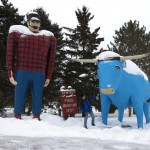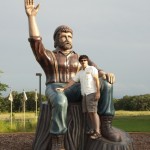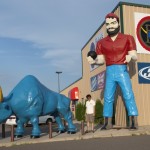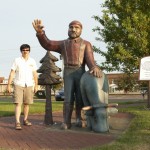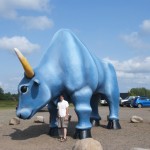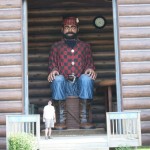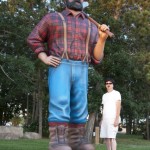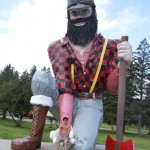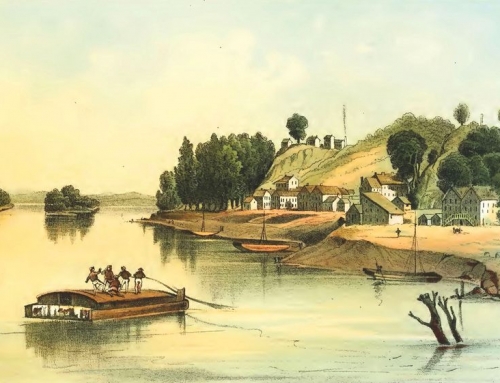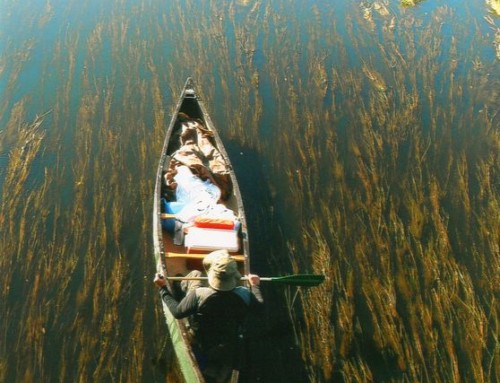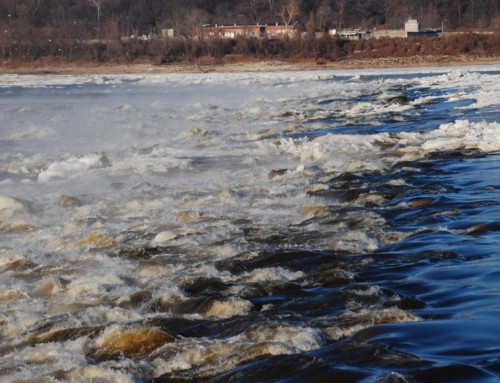To mark the recent release of my fourth Mississippi Valley Traveler guide–the Headwaters Region Guide–here’s an excerpt about one of the region’s larger-than-life characters, Paul Bunyan. You might be surprised by a few things. And don’t forget to check out the photos of Paul and Babe at the end of the post. They get around.
To buy a copy of the book, head here.
Headwaters Guide excerpt:
I didn’t know this until I visited northern Minnesota, but we have Paul Bunyan and Babe the Blue Ox to thank for creating the Mississippi River. I used to think that the river came to be because of things like melting glaciers, easily eroded sandstone, and Mark Twain, but, no; it was Bunyan.
We all know, of course, that Minnesota’s 10,000 lakes were created when Bunyan and Babe hiked around the state, leaving huge footprints in the ground that eventually filled with water. One winter when they were logging trees, Babe was towing a giant water wagon. The road monkeys would coat the roads with water to create an icy surface for those felled logs to slide across. Well, the wagon sprung a leak, as water wagons sometimes do, but this wagon had so much water in it that the flow spilled into a basin that created Lake Itasca, then continued flowing all the way to New Orleans, although obviously not in a direct line.
So who exactly was this Paul Bunyan, creator of rivers and lakes? Folks in Bemidji, Minnesota claim their city as his birthplace, but it seems neighboring Akeley has the stronger claim. “Paul was born here, I’m pretty darn sure of that,” long-time Akeley resident Steve Lindhorst told me in 2011. One thing is clear: he was a freakishly large child from the beginning. “Five giant storks delivered him to us, and boy were they tired when they dropped him off,” his mother told the Bemidji Pioneer. “Within a week he was wearin’ his father’s clothes.” He soon outgrew them. Mrs. Bunyan improvised by “…sewing together some sheets and using wagon wheels as buttons.”
As young Bunyan outgrew the lumber wagon that served as his baby carriage, his parents built a large raft and floated it in the ocean, which is quite a distance from Akeley. Every time young Bunyan rocked back or forth, he sent waves cascading across the ocean, which probably didn’t please many ship captains. Bunyan needed closer and closer supervision as he grew older and bigger. “This one time Paul emptied our fishin’ pond with a single deep breath. We was pickin’ frogs out of his teeth for days,” his mother said.
Bunyan also had a gargantuan appetite; as a child, he could put down 40 bowls of porridge before breakfast. As an adult working in the logging camps, his appetite required special accommodation. The resident blacksmith, Ole, told me that he forged a griddle as large as a Minnesota lake so Sourdough Sam could grill up a heaping stack of pancakes. “We had 50 men skating around that thing with slices of bacon strapped to their feet to keep it greased,” he told me.
Living with Bunyan presented other challenges, too. His voice was so loud that lumberjacks had to wear earplugs or risk going deaf. A single sneeze from Bunyan could blow the roof off a building. One season Bunyan got the flu and sneezed the roofs off of 29 buildings in a single day.
When Bunyan first met Babe the Blue Ox is a matter of contention. The most credible story is that Bunyan found Babe in a snowbank the day the blue snow fell. Bunyan was in such a mighty funk that his melancholy turned the snow blue. (Too bad he wasn’t angry; Babe the Red Ox would be pretty cool!) Most people and critters knew to run and hide, but Babe, who had been a bull of normal hue, was oblivious; when the blue snow fell on Babe, it turned him blue, too. Bunyan felt responsible and took care of Babe from that point on.
Babe’s size eventually rivaled that of Bunyan himself. He grew as tall as 11 pine trees (although we don’t know if he was measured with red, white, or jack pines) and as wide as the Missouri River (again, there is some imprecision here, as the Missouri River is wider near it mouth than at its source). The distance between the tips of Babe’s horns was so remarkable, that “a crow leaving the tip of one horn on a winter’s morning would reach the other tip on a summer’s day.” Given the way crows fly, that’s a heck of a distance.
Yes, Paul Bunyan and Babe lived supersized lives, which is why as you travel around the northern parts of the state, you’ll find so many statues dedicated to them. So when you stand at the northern tip of Lake Itasca, make sure to thank them for all their contributions, including the Mississippi River.
Buy copies of the Headwaters Guide here.
- Paul and Babe in Bemidji
- Paul at Brainerd Lakes Visitor Center
- Paul and Babe at the former Brainerd Bowl
- Paul and Babe in downtown Brainerd
- Babe at Paul Bunyan Land
- Paul at Paul Bunyan Land
- Paul in Pequot Lakes
- Paul in Akeley
© Dean Klinkenberg, 2016
